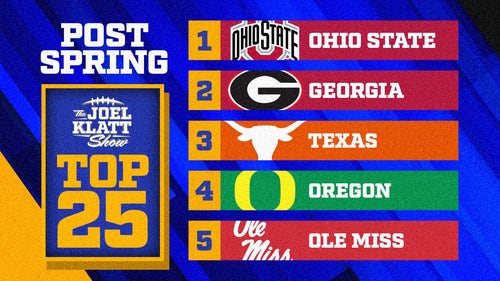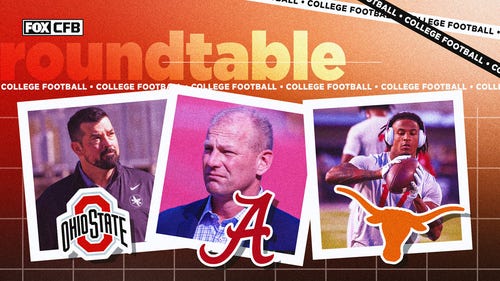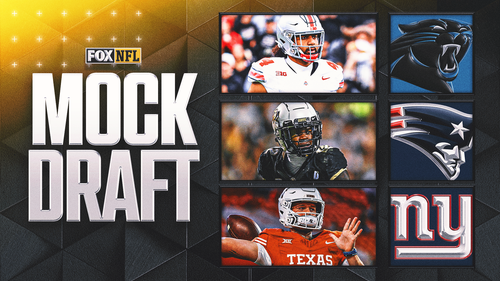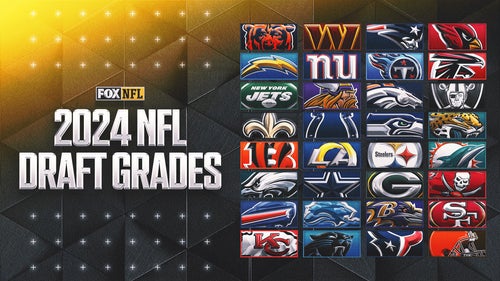
College football recruiting storylines that rule the June calendar
If you think this is a quiet time in college football, you're certainly right when it comes to on-field action.
But when it comes to recruiting, there is plenty of action in June, as this is when most official visits occur.
With that in mind, it's a good time to address some burning questions about summer recruiting. How important are recruiting coordinators in the modern game? Who is the most intriguing unsigned prospect to watch? And where will Jim Harbaugh's rising Michigan program wind up in the recruiting rankings?
FOX Sports college football writers Michael Cohen and Bryan Fischer are here to weigh in on all of it.
Michigan had the No. 1 recruiting class in the country before Georgia picked up several key commitments in the second half of May, most notably five-star quarterback Dylan Raiola, the top prospect in the 247Sports Composite rankings. The last time the Wolverines finished in the top 10 of the national rankings was 2019. Based on Harbaugh's early momentum in 2024, what should be considered a successful finish? Where do you think Michigan ultimately lands?
Michael Cohen: Given where the Wolverines currently sit, anything outside a top-10 finish would be deflating to a fan base that is giddy over the state of the program. With nearly seven months remaining until the early signing period begins in December — and two months beyond that to reach national signing day — Michigan is in prime position with 11 blue-chip prospects and 17 total commitments. By getting so much of his work done early, head coach Jim Harbaugh can spend the summer and fall putting a full-court press on the handful of priority prospects the Wolverines hope to secure as they round out their 2024 class. Some of those names include four-star safety Zaquan Patterson (No. 72 overall, No. 5 S); four-star linebacker Aaron Chiles (No. 73 overall, No. 6 LB); four-star athlete Boo Carter (No. 240 overall, No. 20 ATH) and four-star linebacker Jeremiah Beasley (No. 322 overall, No. 29 LB), among others.
In terms of where Michigan will ultimately finish, the average prospect score from the 247Sports Composite can be an instructive tool. As the class sits, the average score for the 17 players committed to the Wolverines is 91.34 — a figure that ranks sixth nationally behind Alabama (95.40), Georgia (94.14), Florida, (94.04), Ohio State (93.05) and South Carolina (92.95). That number will certainly fluctuate between now and February, but it's worth revisiting past classes to see how a final score of 91.34 ultimately ranked: 12th in 2023; ninth in 2022 and 10th in 2021. It stands to reason the Wolverines will need a few more blue-chippers to guarantee a top-10 finish.
Bryan Fischer: The disconnect between the results on the field and how Michigan has done in the recruiting rankings has been quite eye-opening to the point where you wonder if they've squandered this resurgent run they've been on. I think much of this falls on Harbaugh's shoulders, first for not investing enough time and resources into modern recruiting — and then compounding that by two straight offseasons filled with NFL flirtations. Toss in some assistant coach turnover and the Wolverines did not seem to be capitalizing on their thrust back into the nation's elite.
Things do seem to be changing, however, and the 2024 class could be the fruits of that renewed focus on the prep ranks. They've got a top-notch building block in five-star quarterback Jadyn Davis out of Charlotte, have done well dipping into the Cincinnati area, and are being selective with a few other kids nationally, like four-star OT Blake Frazier out of Texas and four-star TE Hogan Hansen out of Washington.
I would expect that trend line to continue and, depending on how the numbers shake out with transfers, a top-10 class is a pretty good bet — and should probably become the new standard in Ann Arbor moving forward if the program wants to get over their College Football Playoff hump. There's still a long way to go, but landing somewhere in the 7-9 range come the February signing day sounds about right.
It might surprise some people that Florida entered June with four commitments from players ranked among the top 50 players nationally, a statistic only Georgia can match. Five-star quarterback DJ Lagway and four-star prospects Xavier Filsaime (safety), Adarius Hayes (linebacker) and Myles Graham (linebacker) could anchor what has the potential to be a transcendent class for head coach Billy Napier. In an SEC about to get even tougher with the addition of Texas and Oklahoma, where would the Gators land if the league was divided into tiers? Can they regularly challenge for a spot in the College Football Playoff once the format expands?
Bryan: I'm not surprised that Napier has gotten the Gators' recruiting going recently, how could you not with the amount of off-field staff devoted to it in Gainesville nowadays?
That said, I'm not convinced the on-field product is going to get to a place where Florida was regularly in the national title conversation like they were when our FOX colleague Urban Meyer was running the show. The calculus has changed in terms of both in-state competition (FSU rising, Miami getting its act together) and within the conference itself. You're not just dealing with Nick Saban at Alabama and Kirby Smart at Georgia … but also Tennessee getting back near its historical place in the SEC, Texas A&M pumping in a ton of money and even Auburn likely to be trending up under a coach who knows how to win in the league.
And that's before you even get to the new additions of UT and OU.
So regularly challenging for a CFP spot might be a stretch, but there are certainly the resources, talent base and coaching chops to make it something quite feasible every few years.
Michael: Assuming Georgia and Alabama are on a pedestal of their own as winners of the last three national championships, the Gators would probably land in the third tier of the SEC. The second tier should be occupied by LSU, a perennial top-25 team that won the national title in 2019, while the third tier is crowded with the likes of Florida, Tennessee and Ole Miss. The Gators have won 10 or more games just four times since former coach Urban Meyer departed following the 2010 campaign, and they haven't done so since 2019.
Whether Florida can begin challenging for a spot in the expanded College Football Playoff hinges on Napier's ability to adapt to the Power 5 level. The 43-year-old finished 6-7 in his first season with the Gators but averaged 10 wins per season in four years at Louisiana from 2018-21. For now, Napier's report card in Gainesville is incomplete until another season or two unfolds. But scoring significant wins on the recruiting trail is a great way to point the ship in the right direction. Napier already has four commitments from players ranked among the top 50 nationally in the 2024 recruiting cycle, a number the Gators haven't matched since their 2010 class ranked No. 1 in the country.
As most high school prospects begin taking official visits, just six of the top 20 players in the 247Sports Composite rankings have made commitments, led by Railoa to Georgia (No. 1 overall, No. 1 QB) and wide receiver Jeremiah Smith to Ohio State (No. 2 overall, No. 1 WR). Which uncommitted prospect intrigues you the most this summer?
Michael: The recruitment of five-star edge rusher Dylan Stewart (No. 10 overall, No. 2 edge) could be among the most fascinating of the 2024 cycle. At 6-foot-5 and 235 pounds, with a wingspan that is reportedly three inches longer than his height, Stewart has an ideal frame to be a potential plug-and-play option in his freshman season. He had 16 sacks as a junior for Friendship Collegiate Academy in Washington, D.C., in 2022 while guiding his team to a state championship.
Predictably, Stewart's primary suitors all reside in the upper echelon of college football. He reportedly has official visits scheduled at Georgia (June 2), Miami (June 9), Ohio State (June 16) and South Carolina (June 23), with additional interest from the likes of Alabama (one unofficial visit), Penn State (three unofficial visits) and USC, among others. The visit to South Carolina is particularly intriguing a year after five-star athlete Nyckoles Harbor chose the Gamecocks in the 2023 recruiting cycle. Like Stewart, Harbor was a prominent edge rusher from Washington, D.C., and it's possible the two have crossed paths throughout their respective careers.
Bryan: Color me intrigued about Mater Dei (Calif.) defensive lineman Aydin Breland.
As a five-star on one of the nation's best high school teams, you know all the heavy hitters are going to be in play for his recruitment and that is certainly the case with the likes of Georgia, LSU and Ohio State making his top 10 (among others) and pushing hard for a verbal commitment. But this is also going to be an interesting proxy war for the two West Coast programs on his list in Oregon and USC. The two have gone head-to-head plenty over the years but things are much different now that the Trojans will be selling the Big Ten brand of football in their pitch, and the Ducks will be the only ones able to offer Pacific Time Zone proximity for most of the games Breland will be playing in.
Those won't be the only factors that will contribute to Breland's decision, but it will be fascinating to follow how a blue chip player views some of the national powerhouses coming in to recruit him and what it says about programs a little closer to home.
There's an argument to be made that recruiting coordinators have evolved into some of the most important people within a football program outside of the head coach, offensive/defensive coordinators and quarterbacks. In addition to handling initial evaluations, recruiting coordinators are also monitoring the transfer portal year-round and also have their hands in NIL conversations. Should we be discussing and evaluating the quality of recruiting coordinator hires with the same scrutiny applied to offensive and defensive coordinators?
Michael: It's an interesting talking point considering the way recruiting has exploded into a year-round, multi-tentacled machine with the introductions of both NIL and the transfer portal in addition to traditional pursuits of high school athletes. More and more Power 5 schools are modeling their recruiting departments after front offices in the NFL with a general manager-type figure at the top of the chart — in this case, a recruiting coordinator — and separate arms beneath that person for things like high school recruiting and the transfer portal, with dedicated staffers for each. What used to be a one-man show with part-timers and volunteers in support is now its own division in football offices with a dozen or more full-time employees, depending on the program.
The chances of a recruiting coordinator usurping attention from the head coach, quarterback and coordinators is an unlikely prospect during the college football season, though the early signing period in December is a potential exception. But from the second half of January through the end of the quiet period in late June, the people holding positions of power in a program's recruiting department are some of the most important, and most influential, names on the staff directory. Power 5 schools are poaching recruiting talent from top-end programs the same way head coaches and athletic directors look for up-and-comers in the coaching carousel. For that reason alone, it's worth knowing who runs recruiting at your favorite school.
Bryan: Absolutely.
In fact, at programs with aspirations of playing in the CFP regularly, the point person on recruiting might be the most important hire a head coach will make on his staff and contribute far more to the wins and losses than any offensive or defensive coordinator will.
Keep in mind, the modern recruiting coordinator isn't just focused on establishing relationships with prep kids anymore, because there's the constant threat of the transfer portal in terms of both outgoings and incomings when managing the roster numbers. Throw in dealing with an NIL collective or two, and there's a reason why a lot of guys are getting general manager or supercharged associate AD titles nowadays given their importance to what really matters to teams at the highest level.
We certainly don't talk about them as much as we should nationally, but the wise ones know the job they are doing is paramount to every season and that there probably needs to be a much more critical eye applied to just what level of success each is achieving every recruiting cycle.
Michael Cohen covers college football and basketball for FOX Sports with an emphasis on the Big Ten. Follow him on Twitter at @Michael_Cohen13.
Bryan Fischer is a college football writer for FOX Sports. He has been covering college athletics for nearly two decades at outlets such as NBC Sports, CBS Sports, Yahoo! Sports and NFL.com among others. Follow him on Twitter at @BryanDFischer.















































































































































